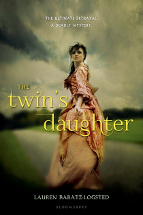The twin's daughter by Lauren Baratz-Logsted

Bloomsbury, 2014. (First published 2010.) ISBN 9781599906614.
The twin's daughter has some elements of the gothic novel.
The atmosphere is one of suspicion, a sense of foreboding, mystery
and danger. Set in Victorian London, the Sexton's home is lavish and
contains the necessary secret tunnel which joins it to the house
next door.
The opening line sets the scene for what is to follow, 'I was
thirteen the year everything changed with a single knock at the
door.' The knock on the door is quickly revealed to be Lucy's
mother's long lost identical twin sister who has been brought up in
the work-house after having being rejected by those who adopted
Lucy's mother. There then takes place a Pygmalion transformation as
Aunt Helen is welcomed into the house and lavished with those
accoutrements her own life never provided - clothes, education and
social graces. Such is the effectiveness of this change that Aunt
Helen and Lucy's mother are sometimes mistaken for each other. It is
this similarity which provides the twists and turns of the plot. The
reader is often invited to question Aunt Helen's real motives even
when Lucy embraces her. The 'unspeakable crime' which occurs halfway
through the story adds yet another twist. On another layer there is
the development of the relationship between Lucy and Kit, the boy
next door, which even less experienced readers can predict will end
in romance. The minor characters of the neighbours and the aged Aunt
Martha who come to visit add little to the story. The themes of
guilt, restitution and growing up are really only shallowly
explored.
The twin's daughter has the necessary ingredients for a
gripping yarn but Baratz-Logsted fails to deliver. The characters
are two dimensional and the plot contrived, failing to effectively
create the atmosphere which would keep a reader turning the pages.
At best it can be described as 'a little bit creepy'.
Barb Rye